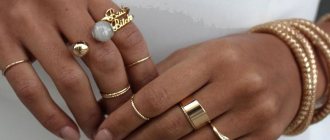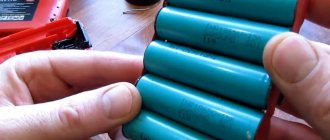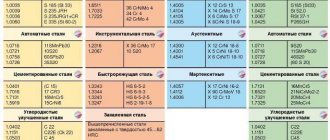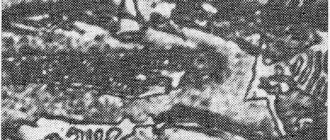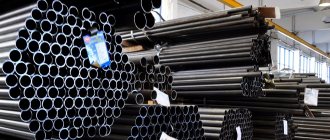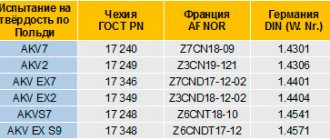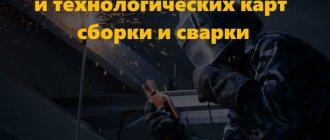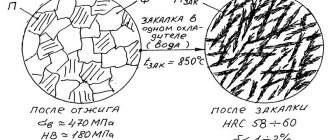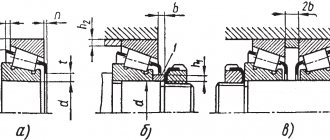According to its characteristics, steel 40X belongs to the group of medium-carbon structural alloy steels. It stands out among others due to its good heat treatment ability. It is one of the most popular grades of metal used in various components of mechanical engineering equipment where increased wear resistance is required. It is highly resistant to corrosion due to its high chromium content.
Characteristics
Operational parameters for steel 40X are determined in the CIS countries by the requirements of interstate GOST 4543-2016. This standard also presents the composition of the chemical elements of its other modified varieties: 40ХПМА, 40ХМФА, 40ХФР, 40ХНМА, 40ХН2МА, 40ХПНМ, 40ХГТР. These products are very similar and differ slightly in chemical composition.
Chemical composition
Let's look at what 40X consists of. The list of its components can be said to be the basis for the creation of other similar alloys. At the same time, the GOST 4543-2016 standard clearly defines the following percentage of chemical elements:
- carbon,% - from 0.36 to 0.44;
- silicon,% - from 0.17 to 0.37;
- manganese,% - from 0.50 to 0.60;
- chromium,% - from 0.80 to 1.10.
Chromium is the main alloying element here. It gives the alloy anti-corrosion properties, appropriate strength and hardness. As can be seen from the composition, its share varies from 0.8 to 1.1% of the total mass.
The standard allows a small amount of: tungsten (up to 0.20%), molybdenum (up to 0.11%) and vanadium (up to 0.05%), which are not considered alloying metals, since they do not affect the basic performance characteristics. It may also contain up to 0.03% titanium in the form of residual impurities.
The above composition may also include the following residual elements, the presence of which is caused by the peculiarities of metallurgical production (the data given below correspond to steel of ordinary quality):
- sulfur,% – no more than 0.035;
- phosphorus,% – not higher than 0.025;
- copper,% – no more than 0.30;
- nickel,% – not higher than 0.30.
By agreement with the customer, the percentage of nickel and copper may not be indicated.
Physical and mechanical characteristics
Correspond to samples after hot rolling or forging (at room temperature):
- density, kg/m3 – 7850:
- tensile strength, MPa – 610;
- yield strength, MPa – 480;
- relative tensile elongation – 0.30…0.45 (the range of indicators is related to the range of rolled products: lower values correspond to samples after sheet rolling);
- elastic modulus (Young's), GPa – 2140;
- impact strength, J/cm2 – 160;
- Brinell hardness, HB – no more than 217 MPa;
- coefficient of thermal expansion (at 20 to 2000C) - 11.8 × 10-6 deg -1.
When using finished products under conditions of alternating and pulsating loads, the endurance limit of steel is also determined, which is 240 MPa.
Replacing steel with bimetal from Element increased the service life of linings 10 times
One crushed stone manufacturer in Karelia recorded a tenfold difference in wear rate between linings made of wear-resistant steel and HYBRID-CR bimetal from Element.
On December 1, 2022, the crushed stone manufacturer installed five wear-resistant HYBRID-CR bimetal plates from Element with a thickness of 10 mm on the transfer unit of the GIS 63 screen. Four months later, the company carried out an interim assessment of the wear of the slabs. 120 thousand tons of gabbro-diabase passed through the unit lined with Element slabs (90 tons per hour). Fractions ranging in size from 20 to 60 mm fell into the screening unit at an angle of 15 degrees from a half-meter height along an inclined tray of 45 degrees.
This volume of rock over four months had virtually no effect on the condition of the linings: wear was only 4%. At the same time, the previously installed lining made of 09G2S steel with a thickness of 16 mm, used under similar conditions, wore out by 60% over the same four months. This means that under these operating conditions, the quality of HYBRID-CR linings allows us to achieve a predicted operating time 10 times longer than steel linings, and this is up to two years of service at the current equipment performance.
Advantages of bimetal
Bimetal stands out among other wear-resistant materials in its ability to protect equipment from several types of wear at once: abrasive, chemical and impact. In addition, bimetallic plates can be heat-resistant and withstand temperatures up to +900 °C. This material prevents rock adhesion, thereby maintaining maximum performance of the unit throughout its entire service life.
Bimetal is produced by electric arc welding, powder sintering or plasma-powder surfacing. When producing boards, Element uses the latest robotic technology and surfacing technology, which allows us to achieve a high degree of process stability, uniform wear resistance properties and surface quality.
Olga Stepuk, manager of the “Wear-resistant materials” direction at Element, noted that in the case of this crushed stone plant, bimetallic plates contain 30% chromium carbides. At the same time, wear resistance is also affected by the uniform arrangement of strictly oriented solid phases in the metal.
“The unique geometry of the carbides is achieved by controlling the cooling rate of the deposited layer. The solid phases are distributed between strictly oriented needle-shaped carbides fixed in the matrix. All this prevents hard particles from being washed out of the softer matrix prematurely,” Ms. Stepuk explained.
Bimetal plates consist of two layers: deposited and base. The first performs the functions of combined protection, and the second is the structural base. At the same time, the thickness of the slabs, despite all the advantages, is usually less than their steel counterparts.
Olga Stepuk added that high-quality bimetal should be covered with surface non-through hardening cracks, which are formed to relieve fatigue stresses.
Replacing steel with bimetal is becoming a fairly popular solution. Thus, in March 2022, Element supplied one of the Siberian quarries with more than two dozen rectangular and round linings for an excavator bucket made of bimetal with cast iron inserts. After an interim inspection 2.5 weeks after installation, the percentage of wear was 0%. Element predicts the service life of its own-produced slabs to be 4 times longer than previously used steel slabs.
The choice of bimetal type depends on the angle and height of the fall of the material, as well as the type of rock. Element specialists will select a suitable solution based on a questionnaire. Send it via email or simply contact Element via the short form.
Element, a manufacturer of replacement and wear parts for mining equipment, offers six effective wear protection solutions: rubber, rubber-ceramic, polyurethane, high molecular weight polyethylene, bimetal and wear-resistant steel. The company offers both linings of standard sizes, which in most cases are in stock, as well as calculation, design and custom manufacturing in accordance with operating conditions.
In Russia and the CIS countries, Element works with ore mining and processing enterprises through the official dealer Nordfelt, and with non-metallic industry companies directly.
As an advertisement
Production conditions
40X is available for mass smelting using the following methods: oxygen-converter, open-hearth, and also in electric arc or induction furnaces. For small batches of high-quality metal, electroslag or plasma-arc remelting methods are used. The metal produced in this way is characterized by more stringent tolerances for the content of harmful metallurgical impurities.
Heat treatment
40X is characterized by good hardenability, which is completely determined by the heat treatment modes. Depending on the subsequent use of the finished products, use:
- hardening at 850 0C in oil, followed by high tempering (final hardness - up to 240...250 HB);
- hardening at 850 0C in oil or water, followed by low tempering (final hardness - up to 510...520 HB);
- Normalization for hardness 170…220 HB.
For the manufacture of gear parts, high-frequency hardening to a hardness of 58...60 HRC can be used, however, after jet hardening in water or salt solutions, the fragility of the metal increases sharply, so tempering is then carried out to 53...56 HRC.
Technological properties
40X is considered relatively brittle, so it is recommended to strictly adhere to the temperature and time range of the tempering. It lends itself well to forging on presses or hammers; the heating of the workpieces for forging is 720...7600C. At the same time, overheating is accompanied by an increase in grain size and an increase in the likelihood of cracks appearing during deformation.
The heat resistance is unsatisfactory; at 150...2000C, a thin film of iron oxide scale begins to form on the surface. As a result, the products quickly rust, and their use in moving parts and machine parts is accompanied by a sharp increase in the coefficient of friction.
Additional processing
The steel obtained during production is sold in the form of rolled products, sheets, rods, etc. etc. Products made from it, to improve the corresponding qualities, are subject to subsequent processing. Thus, during the production of finished products, their strength and wear resistance are increased.
For example, depending on the scope of further application, products made from 40X can undergo additional chemical-thermal treatment (cementation) and surface hardening. Using procedures for implanting nitrogen ions on the surface of the metal, a nitrided layer up to 200 microns thick is obtained, thanks to which the wear resistance of manufactured products increases significantly.
The requirements for further processing, in this case, increase many times, and the cost of production increases.
Mechanical properties of VSt3ps steel
| Test temperature, °C | σ0.2 (MPa) | σв(MPa) | δ5 (%) | ψ % | KCU (J/cm2) |
| Hot rolled billet dimensions 140 x 120 mm | |||||
| 20 | 220 | 445 | 33 | 59 | 154 |
| 300 | 205 | — | — | — | 199 |
| 500 | 180 | 285 | 34 | 80 | 119 |
| Hot-rolled sheets and shapes up to 30 mm thick | |||||
| 20 | 205-340 | 420-520 | 28-37 | 56-68 | — |
| 200 | 215-285 | — | — | — | — |
| 300 | 205-265 | — | — | — | — |
| 400 | 155-255 | 275-490 | 34-43 | 60-73 | — |
| 500 | 125-175 | 215-390 | 36-43 | 60-73 | — |
| A sample with a diameter of 6 mm and a length of 30 mm is forged and normalized. Deformation speed 16 mm/min, strain rate 0.009 1/s | |||||
| 700 | 73 | 100 | 57 | 96 | — |
| 800 | 51 | 63 | 95 | 95 | — |
| 900 | 38 | 65 | 84 | 100 | — |
| 1000 | 25 | 43 | 79 | 100 | — |
| 1100 | 19 | 31 | 80 | 100 | — |
| 1200 | 14 | 25 | 84 | 100 | — |
Analogs
40X - very common in its characteristics. The most famous are the following foreign analogues:
- USA, Canada – 5140, G51400$
- European Union – 1.7035, 37Cr4, 41Cr4;
- Japan – SCr440;
- China – 40Cr, 40CrA.
Technical requirements are established by national and DIN standards.
Physical properties of VSt3ps steel
| Temperature 0C | E 10-5 (MPa) | a 10 6 (1/Deg) | l (W/(m deg)) | r (kg/m3) | C (J/(kg deg)) | R 10 9 (Ohm m) |
| 20 | 1.94 | |||||
| 100 | 1.92 | |||||
| 200 | 1.87 | |||||
| 300 | 1.83 | |||||
| 400 | 1.78 | |||||
| 500 | 1.67 | |||||
| 600 | 1.59 | |||||
| 700 | 1.46 | |||||
| 800 | 1.2 | |||||
| 900 | 0.99 |
Application
Due to low heat resistance and hardness, 40X is not used as hunting or household knives. However, it is widely used in the manufacture of throwing knives and darts. Since this type of tool is characterized by a special form of sharpening of the edge, the high strength of the material and its ability to withstand impact loads are important. In addition, it is easily polished, so products can be quickly restored to their previous condition.
Russian industrial enterprises use this steel to produce shafts, axles, gears and gears, and other products for similar purposes.
Impact strength of steel VSt3ps
| Type of rental | Pattern cutting direction | Section, mm | Temperature +20 °C | Temperature -20 °C | after mechanical aging |
| no less | |||||
| Sheet | Transverse | 5-9 | 78 | 39 | 39 |
| 10-25 | 29 | 29 | |||
| 26-40 | 49 | — | — | ||
| Wide band | Longitudinal | 5-9 | 98 | 49 | 49 |
| 10-25 | 78 | 29 | 29 | ||
| 26-40 | 68 | — | — | ||
| Varietal and shaped | Longitudinal | 5-9 | 108 | 49 | 49 |
| 10-25 | 98 | 29 | 29 | ||
| 26-40 | 88 | — | — | ||
Temperature of critical points of steel 45
As previously noted, to improve the performance properties of the metal, heat treatment is carried out. It involves exerting a certain influence on the structure, after which the crystal lattice is rearranged and the qualities change. When carrying out heat treatment, critical points are often taken into account. Processing of steel St 45 is carried out taking into account the following factors:
- Temperature conditions. It is important to choose the right temperature, since too low will cause incomplete heating of the structure and complete restructuring of the structure will not occur. Too high an indicator causes overheating of the metal, as well as the appearance of scale. A variety of settings can be used to ensure that the required temperature is applied. An example would be blast furnaces or electrical installations. Melting temperatures that are too high determine that it is quite difficult to harden the steel in question at home.
- Rate of temperature increase. The heating rate can also determine which qualities will be transferred to the processed product. Modern equipment allows you to control the heating rate with high precision. For example, HDTVs have an electronic control unit; electrical energy is converted into magnetic energy, which causes heating of the structure.
- The length of time between exposure to different temperatures. When heat treating all metals, the presence of three critical points is taken into account and taken into account. The holding time may depend not only on the chemical composition of the material, but also on the size and shape of the workpiece.
- Features of the cooling process. The quality of the resulting product largely depends on the conditions under which the cooling process took place. For example, it is possible to use oil or water, as well as various powders as a cooling medium.
Quite often, HDTV is used to change the qualities of a metal. It is characterized by high efficiency in application, as well as ease of use. Today there are models that, if desired, can be installed in a home workshop.
Critical points are considered to be temperatures at which restructuring of the structure occurs. There are three main temperature points that are displayed on the plotted diagram.
Attention is also paid to choosing a more suitable cooling medium. For example, it is possible to carry out cooling in water. However, such an environment leads to uneven cooling, which leads to scale and other problems. For higher quality, oil is used. Large workpieces can be cooled in the open air, since it takes a long time to reduce the temperature.
Which is better: galvanized or stainless steel?
In order to successfully solve various technological problems and not get confused: buy a galvanized sheet instead of a stainless steel one, contact a trusted, reputable supplier. Although both metals are corrosion-resistant, and when constructing structures with a service life of no more than 10 years, it is quite possible to get by with cheaper galvanized steel, for critical objects it is still not worth skimping on quality.
A guarantee that you are purchasing a certified product will be choosing as a partner a reliable supplier with attractive market offers. Today we are the best and are ready to supply any volumes of highest quality metal products in the shortest possible time.
Chemical composition of steel 45
In many ways, performance and other qualities are determined by the chemical composition. This is due to the fact that some elements can significantly increase strength, while others increase fragility. The chemical composition of steel 45 is characterized by the presence of the following elements:
- The main chemical elements of St 45 are iron and carbon. The concentration of the second element largely determines how strong and hard the product is. Established standards specify that the carbon concentration should be from 0.42 to 0.5%. At the same time, the metal composition is about 97%.
- The composition includes a relatively small amount of alloying elements. The main ones can be called magnesium and silicon. Their concentration rate is more than 0.1%.
- The concentration of other elements is maintained within a certain range. For example, GOST defines a small amount of sulfur and phosphorus, since these elements lead to deterioration in performance.
The carbon content, like many other elements, is maintained within a certain range. This element largely determines the main characteristics of the resulting products; too high a concentration can lead to surface hardness and structure fragility.
Steel-Maximum: Steel 09G2S
This alloy belongs to the class of structural low-alloy steels. It is used for the manufacture of various metal parts and elements for welded metal structures operating under pressure and at various temperatures.
This type of steel is classified as silicon-manganese. Performed in accordance with GOST 27772-88. Meets the requirements for building structures C345.
The exact chemical composition of steel 09G2S
09G2S
carbon – 0.09% manganese – up to 2% silicon – less than 1%
The steel is low alloy since the total amount of additives ranges from 2.5%. In addition to the main elements, the composition of the 09G2S brand is supplemented by several minor ones.
| Nickel (Ni) | Chromium (Cr) | Copper (Cu) | Arsenic (As) | Sulfur (S) | Phosphorus (P) | Nitrogen (N) |
| less than 0.3 | less than 0.3 | less than 0.3 | up to 0.08 | less than 0.04 | less than 0.035 | up to 0.008 |
Advantages and application of steel 09G2S
Steel 09G2S
does not overheat and does not harden during the welding process. Its plastic properties remain at a high level, and the grain size does not increase. All these characteristics make this alloy ideal for use in welded structures. The welding process can be carried out with or without preheating (up to approximately 100°-120°).
It is this brand that allows you to create the most thin-walled elements, which is excellent for its use in shipbuilding and the construction field. In addition, the material is quite strong and durable, which makes the structure safe.
Sheets made of steel 09G2S bend easily. This allows you to create complex structures for the gas, oil and chemical industries. In such areas, steel products from this grade are presented in the form of pipes and pipeline fittings.
Advantages of steel 09G2S
- High mechanical strength
- Durability – the service life of parts made from this steel is more than 30 years
- Wide operating temperature range – from -70°С to +425°С
- No tendency to temper brittleness
- After tempering, the viscosity of steel does not decrease
- Does not lose ductility and does not change grain size when welding elements
Properties of steel 09G2S
The specific gravity of this alloy is 7.85 g/cm3. The weldability of this steel is not limited.
The critical point temperature is:
- Ac1 = 725°
- Ac3(Acm) = 860°
- Ac3(Acm) = 860°
- Ar1 = 625°
The material has no flake sensitivity and no tendency to temper brittleness.
Forging temperature:
- start – 1250°С
- end – 850°С
Cutting machinability is available in the normalized tempered state δB = 520 MPa, Kυ b.st = 1.0 K υ tv. spl=1.6
Yield strength at different temperatures:
- 250°C = 2207.25 kgf/cm2 (225 MPa)
- 300°C = 1912.95 kgf/cm2 (195 MPa)
- 350°C = 1716.75 kgf/cm2 (175 MPa)
- 400°С = 1520.55 kgf/cm2 (155 MPa)
Domestic and foreign analogues
| Russia | 09G2, 09G2T, 09G2DT, 10G2S |
| Germany | 13Mn6, 9MnSi5 |
| Bulgaria | 09G2S |
| Hungary | Vh3 |
| Romania | 9SiMn16 |
| Japan | SB49 |
| China | 12Mn |
Steel 45
A huge number of different steels are supplied to production lines, which are characterized by their specific properties. An example is the material steel 45, which is widely used. This steel is characterized by certain performance qualities that are worth considering. GOST for steel 45 determines the concentration of all chemicals. The grade is characterized by a relatively low cost, and the decoding of the steel grade determines its wide distribution. Let's take a closer look at the features of this offer.
